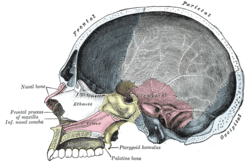Cranial cavity
| Cranial cavity | |
|---|---|
 Body cavities | |
 Cranial cavity | |
| Details | |
| Identifiers | |
| Latin | cavitas cranii |
| TA |
A01.1.00.048 A02.1.00.012 |
| FMA | 9644 |
| Anatomical terminology | |
The cranial cavity, also known as intracranial space, is the space within the skull. The skull, also known as the cranium, contains the brain. Meninges are protective membranes that surround the brain to minimize damage of the brain when there is head trauma. Meningitis is the inflammation of meninges caused by bacterial or viral infections.
The spaces between meninges and the brain are filled with a clear cerebrospinal fluid, increasing the protection of the brain. Facial bones of the skull are not included in the cranial cavity. There are only eight cranial bones: The occipital, two parietal, the frontal, two temporal, the ethmoid and the sphenoid bones are fused together by the ossification of fixed fibrous sutures. The occipital bone found in the rear of the skull is thicker to limit fractures caused by blows to the back of the head.
In the event that the brain strikes the inside of the skull, there is a risk of a minor traumatic brain injury (concussion). This type of injury can alter brain function, cause memory loss, headaches an or nausea. A minor traumatic brain injury can be followed by post concussion syndrome. [1]
The capacity of an adult human cranial cavity is 1,200–1,700 cm3. [2]
See also
References
- ↑ Martini R, Ober W, Garrison C, Welch K, and Hutchings RT. 2001. Fundamentals of Anatomy and Physiology, 5th ed. Prentice Hall, New Jersey. p. 195.
- ↑ Turchin, Valentin. "The Phenomenon of Science".
External links
| Wikimedia Commons has media related to Cranial cavity. |